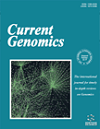- Home
- A-Z Publications
- Current Genomics
- Previous Issues
- Volume 13, Issue 3, 2012
Current Genomics - Volume 13, Issue 3, 2012
Volume 13, Issue 3, 2012
-
-
Application of Genomic Tools in Plant Breeding
More LessAuthors: A. M. Perez-de-Castro, S. Vilanova, J. Canizares, L. Pascual, J. M. Blanca, M. J. Diez, J. Prohens and B. PicoPlant breeding has been very successful in developing improved varieties using conventional tools and methodologies. Nowadays, the availability of genomic tools and resources is leading to a new revolution of plant breeding, as they facilitate the study of the genotype and its relationship with the phenotype, in particular for complex traits. Next Generation Sequencing (NGS) technologies are allowing the mass sequencing of ge Read More
-
-
-
Quantitative Genetics in the Genomics Era
More LessThe genetic analysis of quantitative or complex traits has been based mainly on statistical quantities such as genetic variances and heritability. These analyses continue to be developed, for example in studies of natural populations. Genomic methods are having an impact on progress and prospects. Actual relationships of individuals can be estimated enabling novel quantitative analyses. Increasing precision of linkage map Read More
-
-
-
Application of Genomics Tools to Animal Breeding
More LessThe main goal in animal breeding is to select individuals that have high breeding values for traits of interest as parents to produce the next generation and to do so as quickly as possible. To date, most programs rely on statistical analysis of large data bases with phenotypes on breeding populations by linear mixed model methodology to estimate breeding values on selection candidates. However, there is a long history of Read More
-
-
-
Human Complex Trait Genetics: Lifting the Lid of the Genomics Toolbox - from Pathways to Prediction
More LessAuthors: Suzanne J. Rowe and Albert TenesaDuring the initial stages of the genome revolution human genetics was hugely successful in discovering the underlying genes for monogenic diseases. Over 3,000 monogenic diseases have been discovered with simple patterns of inheritance. The unravelling and identification of the genetic variants underlying complex or multifactorial traits, however, is proving much more elusive. There have been over 1,000 signific Read More
-
-
-
From Genotype x Environment Interaction to Gene x Environment Interaction
More LessBy Jose CrossaHistorically in plant breeding a large number of statistical models has been developed and used for studying genotype x environment interaction. These models have helped plant breeders to assess the stability of economically important traits and to predict the performance of newly developed genotypes evaluated under varying environmental conditions. In the last decade, the use of relatively low numbers of marker Read More
-
-
-
Comparison of Models for the Collinearity of Hox Genes in the Developmental Axes of Vertebrates
More LessHox gene clusters are very frequent in many animal genomes and their role in development is pivotal. Particularly in vertebrates, intensive efforts have established several properties of Hox clusters. The collinearity of Hox gene expressions (spatial, temporal and quantitative) is a common feature of the vertebrates. During the last decade, genetic engineering experiments have revealed some important facets of collinearity Read More
-
-
-
Do Epigenetic Marks Govern Bone Mass and Homeostasis?
More LessAuthors: Jesus Delgado-Calle, Pablo Garmilla and Jose A. RianchoBone is a specialized connective tissue with a calcified extracellular matrix in which cells are embedded. Besides providing the internal support of the body and protection for vital organs, bone also has several important metabolic functions, especially in mineral homeostasis. Far from being a passive tissue, it is continuously being resorbed and formed again throughout life, by a process known as bone remodeling. Bone develo Read More
-
Volumes & issues
-
Volume 26 (2025)
-
Volume 25 (2024)
-
Volume 24 (2023)
-
Volume 23 (2022)
-
Volume 22 (2021)
-
Volume 21 (2020)
-
Volume 20 (2019)
-
Volume 19 (2018)
-
Volume 18 (2017)
-
Volume 17 (2016)
-
Volume 16 (2015)
-
Volume 15 (2014)
-
Volume 14 (2013)
-
Volume 13 (2012)
-
Volume 12 (2011)
-
Volume 11 (2010)
-
Volume 10 (2009)
-
Volume 9 (2008)
-
Volume 8 (2007)
-
Volume 7 (2006)
-
Volume 6 (2005)
-
Volume 5 (2004)
-
Volume 4 (2003)
-
Volume 3 (2002)
-
Volume 2 (2001)
-
Volume 1 (2000)
Most Read This Month
Article
content/journals/cg
Journal
10
5
false
en


